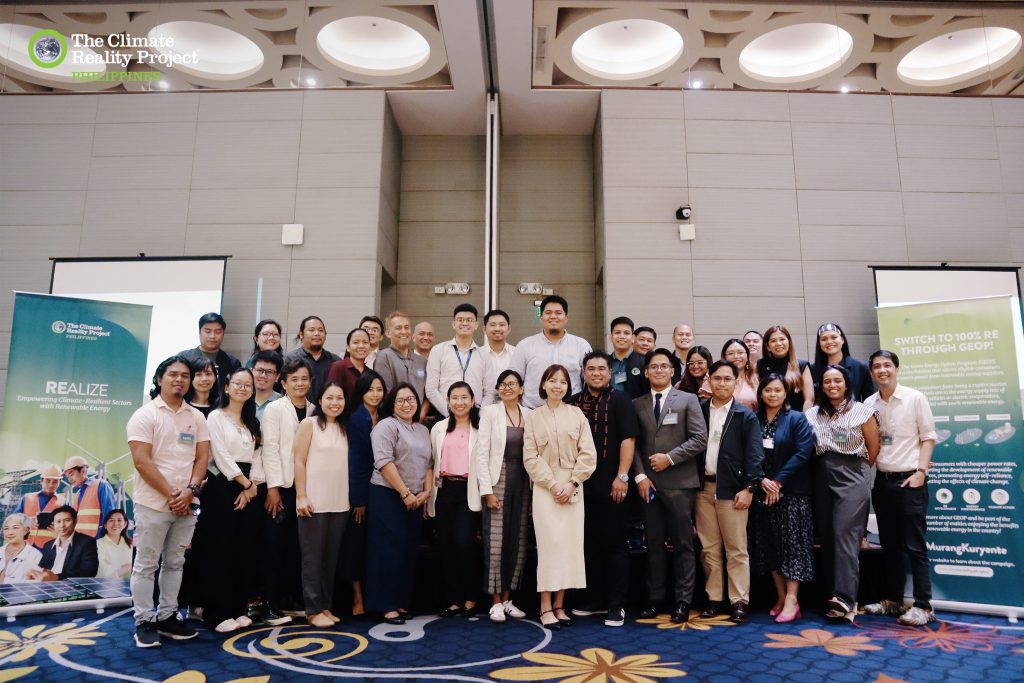QUEZON CITY — The Green Energy Option Program (GEOP) is a viable pathway for hospitals and health facilities to transition towards cleaner and cheaper energy while supporting climate mitigation.
This was recognized during The Climate Reality Project Philippines’ REalize for Hospitals: Empowering a Climate-Resilient Health Sector with Renewable Energy, organized in partnership with Health Care Without Harm, on 13 May 2024.
“We aim to have an efficient health infrastructure with an aim of decarbonization. We are very excited about GEOP. We want at an early stage to incorporate green initiatives knowing that our operations are 24/7,” said Assistant Secretary Charade B. Mercado-Grande, lead of the Health Regulation and Facility Development Cluster of the Department of Health (DOH).
Choosing renewable energy
The DOH presented its 8-Point Action Agenda, a comprehensive plan stipulating the sector’s strategies to provide Filipino communities with holistic healthcare services. One of the strategies is Handa sa Krisis, which aims to adopt green health facilities and low-carbon infrastructures where renewable energy is the cornerstone.
“Renewable energy is a readily accessible and increasingly cost-effective solution to meet our energy needs while mitigating climate change and transitioning towards a more sustainable energy future,” explained Engr. Jephraim Manansala, chief data scientist of the Institute for Climate and Sustainable Cities (ICSC).
According to the Department of Energy (DOE)’s Grid Planning and Competitive Renewable Energy Zones in the Philippines Report shared by Manansala, the hydropower resource alone can harness 655,034 megawatts, which exceeds the country’s peak demand of 16,000 megawatts. Being an indigenous resource, renewable energy meets the energy requirement of Filipinos in a least-cost manner.
“Renewable has reduced the settlement price of electricity by 28% during peak hours even with less than 3% share in the energy mix,” he added.
Matthew Carpio, head of Transaction Advisory of Climate Smart Ventures, applauded DOE’s exemplary initiatives to expand the development and utilization of renewable energy in the country.
“We are liberated in terms of power generation. DOE just came out with new standards for 100% foreign ownership. It unlocked a new set of investors that were not previously open to the Philippines,” he cited.
Greening the health sector with GEOP
“Healthcare’s climate footprint is 4.4% of global net emissions equivalent to 514 coal-fired power plants. If healthcare were a country, it would be the fifth largest climate polluter on the planet,” described Manjit Kaur Sohal, regional climate manager of Health Care Without Harm Southeast Asia.
This poses an urgency for the national government to decarbonize health sectors by powering operations with 100% renewable energy, investing in zero-emission infrastructures, producing low-carbon pharmaceuticals, and implementing circularity within the healthcare system.
During a roundtable discussion with the Asian Development Bank (ADB) in March, the DOH recognized the critical role of renewable energy in achieving a climate-smart healthcare infrastructure and system. To achieve this, the DOH called for an expedited process for public healthcare facilities across the country to access GEOP.
“Through GEOP, hospitals can source 100% of their power from renewable energy resources without spending on infrastructure, significantly reducing their carbon footprint and achieving substantial power cost savings. This makes GEOP an ideal springboard for the healthcare sector’s journey towards decarbonization,” said Nazrin Camille Castro, the branch manager of The Climate Reality Project Philippines.
GEOP is a pathway for the healthcare sector to begin its transition to cleaner energy and attain its net-zero agenda. Hospitals with a monthly average peak demand of at least 100 kWh have the power to choose renewable energy as their power source without upfront costs. This protects hospitals from fossil fuel crises and price volatility in the global market.
Engr. Jordan Ballaran, senior science research specialist of the DOE, also regarded GEOP as a mechanism that can empower the health sector to contribute to realizing the country’s renewable energy targets. Engr. Patrick Pondevida, Senior Accountant Manager of ACEN Corporation, affirmed this by emphasizing that hospitals entering into a contract with GEOP paves the way for new renewable energy plans and development in the Philippines; thus, veering away from reliance on traditional sources of power like coal and fossil gas.
ACEN Corporation is one of the renewable energy suppliers under GEOP that supplies power to EL Laboratories, a pharmaceutical manufacturing company in Biñan, Laguna.
Switching to GEOP
Renewable energy emerges as the cheapest energy source that is reflective of the competitive generation rates offered in GEOP, saving hospitals a significant amount of their operational expenses. These savings can be redirected to enhance services, improve equipment, or expand access to care. Moreover, the program also assures hospitals with 100% renewable energy in cases where replacement or backup power is needed.
“Most of the customers say that once you shift to renewable energy [GEOP], there is reliability in power. We will ensure that the supply is there. Let us say, 1,900 MW are down. The renewable energy supplier should be the one responsible for replacing the power for our customers,” Engr. Pondevida explained.
In order to switch to GEOP, hospitals need to find their renewable energy supplier among the 18 accredited entities of the program and inform their local distribution utility about the intent to switch. Learn more about the switching process here.
Climate Reality Philippines assists end-users across different industries to realize their vision of more sustainable and climate-resilient operations with GEOP through a series of REalize Conferences slated throughout the year. Health is the first focus sector of the series and will be targeting the tourism, telecommunications, and academic sectors in the succeeding legs.

